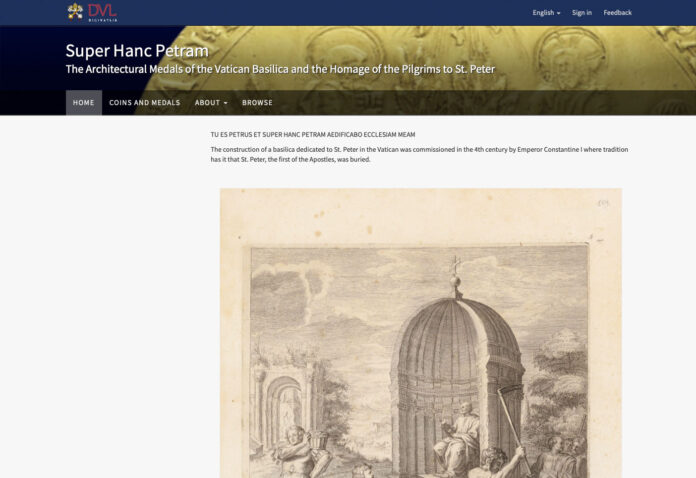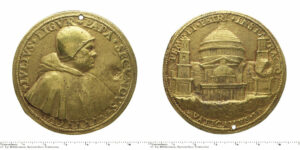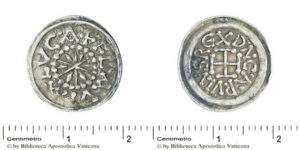
The exhibition “Super hanc petram” enriches the platform Thematic Pathways on the web of the Vatican Apostolic Library compliant with the IIIF (International Image Interoperability Framework) interoperability protocol, adopted by the most important digital libraries that freely offer millions of of digitized images. The history of the reconstruction of St. Peter’s through the medals bearing on the reverse the architectures of the Basilica and the small selection of coins left by pilgrims around St. Peter tomb are the topic of a story told in form of virtual exhibition thanks to the “exhibit” of the Spotlight, the open source software in which the Pathways are managed.

The construction of a basilica dedicated to St. Peter in the Vatican was commissioned in the 4th century by emperor Constantine I in the place where tradition has it that St. Peter, the first of the Apostles, was buried. On 18th April 1506, after more than ten centuries since it was built, as it was decrepit, Pope Julius II laid the first stone of the new and current basilica of St. Peter in the Vatican together with a foundational medal probably created by the engraver Cristoforo Foppa called Caradosso, and bearing, on the reverse, the project of the apse. In fact, at first, he wanted Michelangelo to build his funerary monument in exact correspondence with the apse, but then only a reduced version of it was realized in St. Peter in Chains.
From that moment on, several medals marked all the most salient moments of the reconstruction of the symbol of Christianity par excellence, which since the first construction has welcomed large numbers of pilgrims arriving in Rome from all over Europe.

They, indeed, wished to pay homage to the Prince of the Apostles, leaving a coin marking their presence at the foot of the various altars superimposed over the centuries on the original sepulcher. These coins, which were continually left by pilgrims, were generally collected at the end of the day by appointed personnel; some of them ended up, for one reason or another, for example through cracks in the pavement or through small openings in the aforementioned altars, under the floor of the church itself, often near the place where the Apostle’s tomb was thought to be. In addition to them, there were also the coins left in this same place by famous people who could be accompanied to the tomb thanks to particular privileges. For example, this is the case of the gold coin – the only one in this collection – that Charlemagne left near the tomb of St. Peter on the occasion of one of his visits to Rome. A great number of these coins was discovered during the excavations of the years 1939-1949 promoted by Pius XII in search of the burial of St. Peter in the Vatican.

They constitute a very important documentation of the fact that devotees of all ages always knew what Pius XII officially confirmed to the world in the radio message of 23rd December 1950 at the end of the excavation works: (…) The gigantic dome arches exactly over the sepulcher of the first Bishop of Rome, of the first Pope, a sepulcher which was originally very humble, but over which the veneration of the following centuries, with a marvelous succession of works, erected the maximum temple of Christianity.
Here you can access the exhibition “Super hanc petram”. It opens with a brief presentation and it can be explored clicking on coins and medals. By selecting each item on the list, visitors will have access to the images of the coins or medals – that they can enlarge as they like, to fully enjoy even the smallest details – and to their descriptive metadata. The exhibition is completed by the list of engravers mentioned in the descriptive comments.
For further information, visit the website of the Biblioteca Apostolica Vaticana.
We presented in our Who’s who the author Eleonora Giampiccolo, Director of the Numismatic Department of the Vaticon Library.




